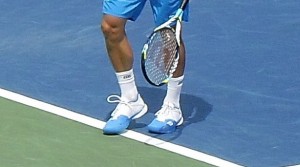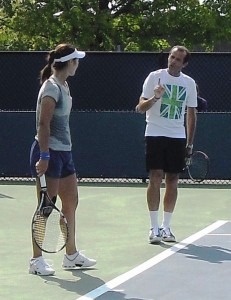2014 season has begun with several unexpected events that set the stage for a terrific year in tennis. The Australian Open, although by now it seems to be a distant memory, provided a number of spectacular matches and ended with a surprise women’s final in which Li Na captured her second Slam and her first Australian Open titles, defeating Dominika Cibulková in the finals. She also went through the draw without facing a single top 10 opponent. On the men’s side, Stanislas Wawrinka did a couple of things that he has never done in the previous 12 meetings against Nadal: win a set, and then win the match. He also defeated the world number one Novak Djokovic en route to the title. His win was overshadowed by Nadal’s injury in the second set which caused the Spaniard to play the rest of the match at less than one-hundred percent; however it should take nothing away from the Swiss’ well-deserved title, especially considering that he was dominating the match when Nadal injured his back in the second set.
On the one hand, Djokovic’s early form produced a couple of disappointing losses and no titles, putting question marks next to the Nole-Boris collaboration that began two months ago. I find it premature to question the partnership based on two losses to two in-form players, Wawrinka and Roger Federer. While Nole has not necessarily looked to be in top form à-la-2011, he has certainly not played poorly either. The Indian Wells and Miami tournaments should shed more light on the direction of the partnership. On the other hand, Federer seems to have found his good form. He played better in the Australian Open, even in his semi-final loss against Nadal, than he has played throughout 2013, and performed impeccably in the Dubai tournament, especially in the third sets against Nole in the semi-finals and against Thomas Berdych in the finals, before capturing his 78th career tournament victory.
Like Djokovic, Serena Williams has suffered couple of unexpected losses, first to Ana Ivanovic at the Australian Open, then to Alize Cornet in the semifinals of the Dubai tournament. Unfortunately, her after-match comments following her loss to Cornet once again showed the stunningly wide gap between the amounts of class that exist amongst the elite of men’s tennis and that of women’s. John Isner pointed out after his victory against Juan Martin Del Potro in Cincinnati several months ago that the top guys in men’s tennis were all class acts, and it shows in their comments about each other in the post-match conferences as well as how they handle the fans and the media. What do the elite women have to show in comparison? Bunch of players who never talk to each other, who do not acknowledge some of the lower-ranked players in the locker room, and who, like Serena did following her loss to a lesser-ranked opponent, cannot find the magnanimity to simply say “my opponent was better than me today, all the credit goes to her.” instead, Serena sarcastically chuckled and laughed through the questions saying how embarrassed she was to have lost (to Cornet) and that she has not played that poorly since three or four years ago. There is no need to wonder why women’s tennis is losing audience while men’s tennis is flourishing: if I were the WTA, I would desperately search for ways to make the top faces of the tour more identifiable to fans. There is more to being a ‘complete’ player on the tour than shrieking on the court as loud as possible and grimacing as if it was a miracle when an opponent hits a good shot.
Davis Cup also produced the unexpected so far, with Spain, minus Nadal and David Ferrer, losing to Germany, and Serbia, minus Nole, losing to Switzerland that featured both Wawrinka and Federer. With teams like Kazakhstan, Japan, and Great Britain in the quarterfinals, the last one making it to this stage for the first time since 1986, the weekend of April 4-6 promises to be an exciting weekend. If Andy Murray plays, the tie between Italy and Great Britain in Naples, Italy, looks to be the most compelling tie of the quarterfinals.
I close this article with an “I told you so” anecdote. For years, I have been saying that I found it disingenuous that the players constantly complained about the length of the season and argued that the season should be cut shorter so that they could have time to recuperate from a grueling season of tennis. I did not believe in their candidness at the time because many of them scheduled exhibition matches, and traded trips and days in the hotel to pocket more money instead of resting and staying home like they claimed they desired to do. Now the hypocrisy is official. The International Tennis Premier League (ITPL) is set to begin its first year of competition at the end of this year, and just about every top player in women’s and men’s fields, as well as some legends such as Andre Agassi and Pete Sampras, have signed up for the event that will occupy half of the period of the so-called 7 weeks of rest following the WTA and ATP year-ending championships.
The competition will take place in Asia, putting players like Nadal, Djokovic and Williams in traveling mode and hotels for over three weeks at a time that they supposedly need their rest. Yes, the matches are supposed to be one set only per match, and yes maybe the intensity may not be what it is in the Slam tournaments, but when there is money to be made, you can bet that the competition will not be taken lightly either. It will certainly require an intensity level that is higher than that of an exhibition match. I am simply curious to see how Nadal, Nole, Murray, Williams, Victoria Azarenka, and Caroline Wozniacki will answer the tough questions by the press about the need for “rest.” If Roger Federer were to win the 2015 Australian Open, and Maria Sharapova and Li Na were to play in the women’s finals, I will certainly not want to hear about how well-rested those three were because they chose not to participate in the ITPL. The “worn-out” excuse will not carry much weight at that time.
No more tired legs excuse in the end of 2014!



